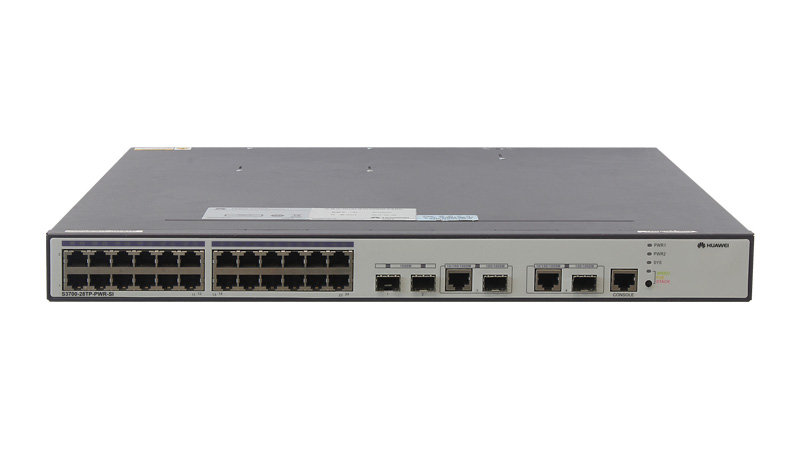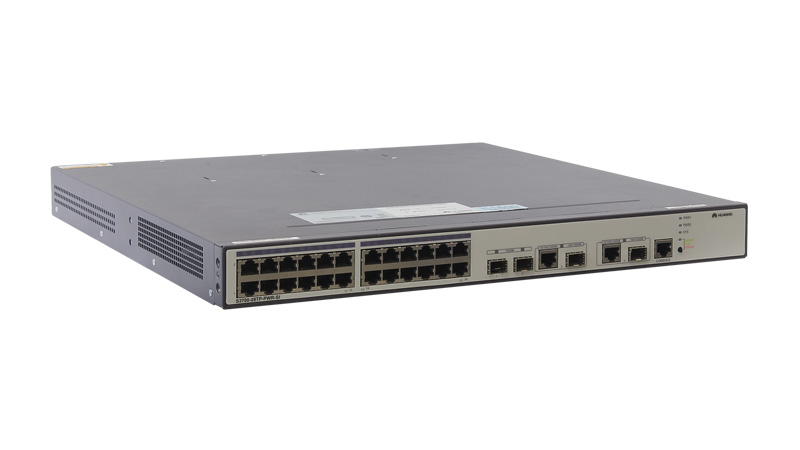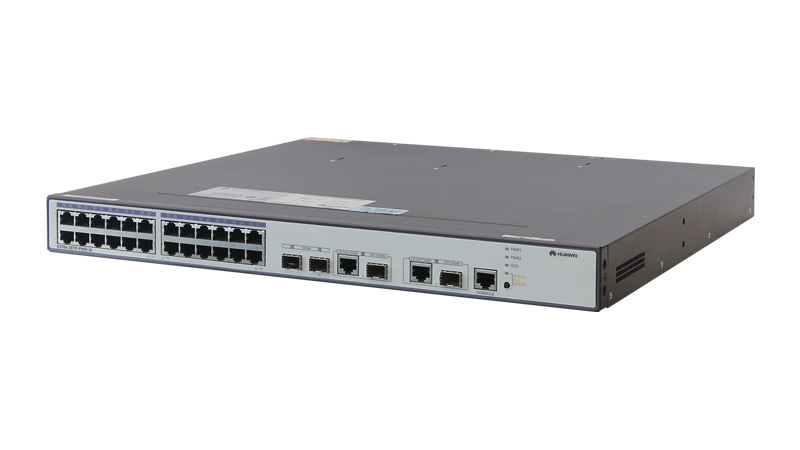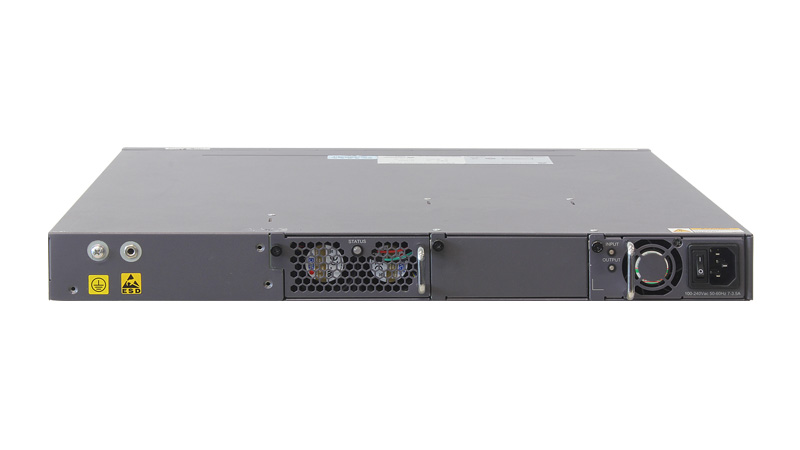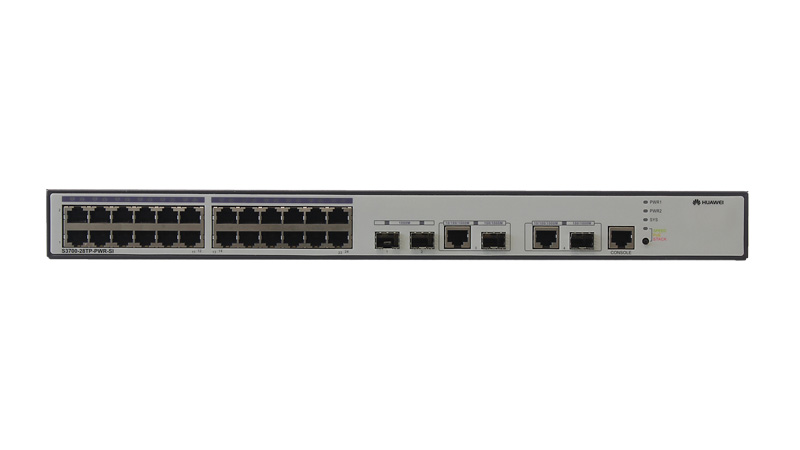Switch empresariales de la serie S3700
Los switch empresariales de la serie S3700 (S3700 de forma abreviada) son switch de capa 3 de próxima generación que permiten el ahorro de energía. El S3700 utiliza hardware de vanguardia y el software de la Plataforma de Enrutamiento Versátil (VRP) de Huawei para proporcionar acceso y agregación de alto rendimiento a las redes de área de campus empresariales. El S3700 es fácil de instalar y mantener. Gracias a su implementación flexible de VLAN, sus capacidades PoE, las funciones de enrutamiento integrales y la capacidad de migrar a una red IPv6, el S3700 permite a los clientes empresariales construir redes IT de próxima generación. Además, el S3700 utiliza tecnologías avanzadas de confiabilidad, como apilamiento, VRRP y RRPP. Esto permite mejorar la confiabilidad y diversidad de la red.
● CE de múltiples instancias de VPN (MCE)
● Protocolos de enrutamiento IPv6: RIPng, OSPFv3
● Apilamiento inteligente iStack
● Protocolo de Protección Rápida de Anillos (RRPP) y Protección
Inteligente de Ethernet (SEP)
● Detección de Reenvío Bidireccional (BFD)
● Mensaje “Dying Gasp”
La serie S3700 son switch fijos con versiones estándar (SI) y mejoradas (EI).
Powerful support for services
The S3700 provides the Multi-VPN-Instance CE (MCE) function to isolate users in different VLANs on a device, ensuring data security and reducing costs.
The S3700 supports multicast functions such as IGMP snooping, IGMP filter, fast leave, and IGMP proxy.
PoE function
The S3700 PWR offers an improved Power over Ethernet (PoE) function. Users can determine when or whether a PoE port provides power.
Comprehensive QoS policies and security mechanisms
The S3700 classifies complex traffic based on packet information such as the 5-tuple, IP preference, ToS, DSCP, IP protocol type, ICMP type, TCP source port, VLAN ID, Ethernet protocol type, and CoS. The S3700 supports a flow-based two-rate three-color CAR.
The S3700 provides multiple security measures to defend against Denial of Service (DoS) attacks, as well as attacks against networks or individual users. DoS attack types include SYN Flood attacks, Land attacks, Smurf attacks, and ICMP Flood attacks.
The S3700 supports DHCP snooping, which generates user binding entries based on users’ access interfaces, MAC addresses, IP addresses, IP address leases, and VLAN IDs.
The S3700 supports strict ARP learning, which prevents ARP spoofing attacks that exhaust ARP entries. The S3700 also provides IP source guard to prevent DoS attacks caused by MAC address spoofing, IP address spoofing, and MAC/IP spoofing.
The S3700 supports centralized MAC address authentication and 802.1x authentication. It authenticates users based on statically or dynamically bound user information, such as the user name, IP address, MAC address, VLAN ID, access interface, and flag indicating whether antivirus software is installed. VLANs, QoS policies, and ACLs can be dynamically applied to users.
The S3700 can limit the number of MAC addresses learned on an interface to prevent attackers from exhausting MAC address entries by using bogus source MAC addresses. This function minimizes the packet flooding that occurs when users' MAC addresses cannot be found in the MAC address table.
Various routing and IPv6 features
The S3700 supports various routing protocols, including static routing, RIP, OSPF, IS-IS and BGP.
S3700 hardware supports IPv4/IPv6 dual stack, IPv6 over IPv4 tunnels (including manual tunnels, 6to4 tunnels, and ISATAP tunnels), and Layer 3 line-speed forwarding.
High scalability and excellent reliability
The S3700 supports intelligent stacking (iStack). Multiple S3700s can be connected with stack cables to set up a stack, which functions as a virtual switch.
Besides STP, RSTP, and MSTP, the S3700 supports enhanced Ethernet reliability technologies, such as Smart Link and RRPP, which implement millisecond-level protection switchovers and ensure network reliability.
The S3700 supports BFD, which provides millisecond-level fault detection for protocols, such as OSPF, IS-IS, VRRP, and PIM to improve network reliability.
Maintenance-free design and manageability
The S3700 adopts a maintenance-free design and supports batch remote upgrade. It provides multiple maintenance and management modes to help users to monitor various data.
The S3700 supports GARP VLAN Registration Protocol (GVRP), which dynamically distributes, registers, and propagates VLAN attributes to reduce network administrator workloads and ensure the correct configuration of VLANs. In a complex network topology, GVRP simplifies VLAN configuration and reduces network communication faults caused by incorrect VLAN configuration.
The S3700 supports MUX VLAN. MUX VLAN isolates the Layer 2 traffic between interfaces in a VLAN. Interfaces in a subordinate separate VLAN can communicate with ports in the principal VLAN, but cannot communicate with each other.
Unique fan-free and energy-saving design
S3700s that are equipped with 24 electrical ports offer a fan-free design, which dramatically reduces power consumption and eliminates noise.
The S3700 incorporates an energy-saving integrated circuit design to ensure even heat dissipation. Idle ports can enter a sleep mode to further reduce power consumption.
Radiation produced by the S3700 is within the standard range for electric appliances and causes no harm to the human body.
| Item | S3700-SI | |
|---|---|---|
| S3700- 28TP -SI | S3700- 52P-SI | |
| 100M port | 24*10/100Base-TX | 48*10/100Base-TX |
| 1000M port | 2*1000Base-X, 2*(10/100/1000Base-T, or 100/1000Base-X) | 2*100/1000Base-X, 2*1000Base-X |
| Extended slot | The S3700HI provides an extended slot for an uplink subcard | |
| MAC address table | IEEE 802.1d compliance 16 K MAC address entries MAC address learning and aging Static, dynamic, and blackhole MAC address entries Packet filtering based on source MAC addresses | |
| VLAN | 4 K VLANs Guest VLANs, voice VLAN, and super VLAN VLAN assignment based on MAC addresses, protocols, and IP subnets QinQ Selective QinQ 1:1 VLAN mapping N:1 VLAN mapping | |
| Reliability | RRPP (ring topology, intersecting rings, and multi-instance), implementing protection switchover within 50 ms Smart Link tree topology and Smart Link multi-instance, providing the millisecond-level protection switchover STP, RSTP, and MSTP BPDU protection, root protection, and loop protection Smart Ethernet Protection (SEP) | |
| IP routing | Static routing, RIPv1, RIPv2, and ECMP | |
| IPv6 features | Neighbor Discovery (ND) Path MTU (PMTU) IPv6 ping, IPv6 tracert, and IPv6 Telnet Manually configured tunnel 6to4 tunnel ISATAP tunnel ACLs based on the source IPv6 address, destination IPv6 address, Layer 4 ports, or protocol type MLD v1/v2 snooping | |
| Multicast | 1 K multicast groups IGMP v1/v2/v3 snooping and IGMP fast leave Multicast VLAN and multicast replication between VLANs Multicast load balancing among member ports of a trunk Controllable multicast Port-based multicast traffic statistics | |
| QoS/ACL | Rate limiting on packets sent and received by an interface Packet redirection Port-based traffic policing and two-rate three-color CAR Eight queues on each port WRR, DRR, SP, WRR+SP, and DRR+SP queue scheduling algorithms WRED (S3700HI) Re-marking of the 802.1p priority and DSCP priority Packet filtering at Layer 2 to Layer 4, filtering out invalid frames based on the source MAC address, destination MAC address, source IP address, destination IP address, port number, protocol type, and VLAN ID Rate limiting in each queue and traffic shaping on ports | |
| Security | User privilege management and password protection DoS attack defense, ARP attack defense, and ICMP attack defense Binding of the IP address, MAC address, interface, and VLAN Port isolation, port security, and sticky MAC Blackhole MAC address entries Limit on the number of learned MAC addresses 802.1x authentication and limit on the number of users on an interface AAA authentication, RADIUS authentication, HWTACACS authentication, and NAC SSH v2.0 CPU defense Blacklist and whitelist | |
| Surge protection | All service ports have a surge protection capability of 6 KV, which can be increased to 15 KV by using additional surge protection devices. | |
| Management and maintenance | iStack (except the S3700HI) MAC Forced Forwarding (MFF) Remote configuration and maintenance by using Telnet Auto-Config Virtual cable test Ethernet OAM (IEEE 802.3ah and 802.1ag) Dying gasp power-off alarm(S3700-28TP-EI-MC-AC and S3700-26C-HI) Port mirroring and RSPAN (remote port mirroring) SNMPv1/v2/v3 and RMON MUX VLAN and GVRP Web NMS Auto-Config and HGMP SSHv2 HTTPS (S3700HI) 802.3az EEE(S3700HI) System logs and alarms of different levels | |
| Operating environment | Operating temperature: 0OC–50OC (long term); -5OC–55OC (short term) Relative humidity: 10%–90% (non-condensing) | |
| Power supply | AC: Rated voltage range: 100 V to 240 V AC; 50/60 Hz Maximum voltage range: 90 V to 264 V AC; 50/60 Hz DC: Rated voltage range: –48 V to –60 V DC Maximum voltage range: –36 V to –72 V DC Note: PoE-support switches do not use DC power supplies. | |
| Dimensions (W x D x H) | S3700-28TP-EI/SI, S3700-28TP-EI-MC, S3700-28TP-EI-24S, S3700-52P-EI/SI , S3700-26C-HI: 442 mm x 220 mm x 43.6 mm S3700-28TP-PWR-EI, S3700-52P-EI-48S, S3700-52P-EI-24S, S3700-52P-PWR-EI: 442 mm x 420 mm x 43.6 mm | |
| Weight | < 2.5 kg | < 3 kg |
| Power consumption | < 20 W | < 38 W |
| Item | S3700-EI | ||||||
|---|---|---|---|---|---|---|---|
| S3700- 52P- EI |
S3700- 52P- EI-24S |
S3700- 52P- EI-48S |
S3700- 52P- PWR-EI | ||||
| 100M port | 48*10/100 Base-TX |
24*10/100 Base-TX, 24*100 Base-FX |
48*100B ase-FX, |
48*10/10 0Base-TX | |||
| 1000M port | 2*100/1000 Base-X, 2*1000 Base-X |
2*100/1000 Base-X, 2*1000 Base-X |
2*100/1000 Base-X, 2*1000 Base-X |
2*100/1000 Base-X, 2*1000 Base-X | |||
| Extended slot | The S3700HI provides an extended slot for an uplink subcard | ||||||
| MAC address table | IEEE 802.1d compliance 16 K MAC address entries MAC address learning and aging Static, dynamic, and blackhole MAC address entries Packet filtering based on source MAC addresses | ||||||
| VLAN | 4 K VLANs Guest VLANs, voice VLAN, and super VLAN VLAN assignment based on MAC addresses, protocols, and IP subnets QinQ Selective QinQ 1:1 VLAN mapping N:1 VLAN mapping | ||||||
| Reliability | RRPP (ring topology, intersecting rings, and multi-instance), implementing protection switchover within 50 ms Smart Link tree topology and Smart Link multi-instance, providing the millisecond-level protection switchover STP, RSTP, and MSTP BPDU protection, root protection, and loop protection Smart Ethernet Protection (SEP) | ||||||
| BFD for OSPF, BFD for IS-IS, BFD for VRRP, and BFD for PIM | |||||||
| IP routing | Static routing, RIPv1, RIPv2, and ECMP | ||||||
| OSPF, IS-IS, and BGP | |||||||
| IPv6 features | Neighbor Discovery (ND) Path MTU (PMTU) IPv6 ping, IPv6 tracert, and IPv6 Telnet Manually configured tunnel 6to4 tunnel ISATAP tunnel ACLs based on the source IPv6 address, destination IPv6 address, Layer 4 ports, or protocol type MLD v1/v2 snooping | ||||||
| Multicast | 1 K multicast groups IGMP v1/v2/v3 snooping and IGMP fast leave Multicast VLAN and multicast replication between VLANs Multicast load balancing among member ports of a trunk Controllable multicast Port-based multicast traffic statistics | ||||||
| IGMP v1/v2/v3, PIM-SM, PIM-DM, and PIM-SSM | |||||||
| QoS/ACL | Rate limiting on packets sent and received by an interface
Packet redirection Port-based traffic policing and two-rate three-color CAR Eight queues on each port WRR, DRR, SP, WRR+SP, and DRR+SP queue scheduling algorithms WRED (S3700HI) Re-marking of the 802.1p priority and DSCP priority Packet filtering at Layer 2 to Layer 4, filtering out invalid frames based on the source MAC address, destination MAC address, source IP address, destination IP address, port number, protocol type, and VLAN ID Rate limiting in each queue and traffic shaping on ports | ||||||
| Security | User privilege management and password protection DoS attack defense, ARP attack defense, and ICMP attack defense Binding of the IP address, MAC address, interface, and VLAN Port isolation, port security, and sticky MAC Blackhole MAC address entries Limit on the number of learned MAC addresses 802.1x authentication and limit on the number of users on an interface AAA authentication, RADIUS authentication, HWTACACS authentication, and NAC SSH v2.0 CPU defense Blacklist and whitelist | ||||||
| Surge protection | All service ports have a surge protection capability of 6 KV, which can be increased to 15 KV by using additional surge protection devices. | ||||||
| Management and maintenance | iStack (except the S3700HI) MAC Forced Forwarding (MFF) Remote configuration and maintenance by using Telnet Auto-Config Virtual cable test Ethernet OAM (IEEE 802.3ah and 802.1ag) Dying gasp power-off alarm(S3700-28TP-EI-MC-AC and S3700-26C-HI) Port mirroring and RSPAN (remote port mirroring) SNMPv1/v2/v3 and RMON MUX VLAN and GVRP Web NMS Auto-Config and HGMP SSHv2 HTTPS (S3700HI) 802.3az EEE(S3700HI) System logs and alarms of different levels | ||||||
| Operating environment | Operating temperature: 0OC–50OC (long term); -5OC–55OC (short term) Relative humidity: 10%–90% (non-condensing) | ||||||
| Power supply | AC: Rated voltage range: 100 V to 240 V AC; 50/60 Hz Maximum voltage range: 90 V to 264 V AC; 50/60 Hz DC: Rated voltage range: –48 V to –60 V DC Maximum voltage range: –36 V to –72 V DC Note: PoE-support switches do not use DC power supplies. | ||||||
| Dimensions (W x D x H) | S3700-28TP-EI/SI, S3700-28TP-EI-MC, S3700-28TP-EI-24S, S3700-52P-EI/SI , 3700-26C-HI: 442 mm x 220 mm x 43.6 mm S3700-28TP-PWR-EI, S3700-52P-EI-48S, S3700-52P-EI-24S, S3700-52P-PWR-EI: 442 mm x 420 mm x 43.6 mm | ||||||
| Weight | < 3 kg | < 4.8 kg | < 4.8 kg | < 4.5 kg (without power supply) | |||
| Power consumption | < 38 W | < 66 W | < 92 W | <880 W (PoE power: 740 W) | |||
| Item | S3700-EI | ||||
|---|---|---|---|---|---|
| S3700 -28TP-EI, S3700 -28TP -EI-MC |
S3700- 28TP- PWR-EI |
S3700- 28TP- EI-24S | |||
| 100M port | 24*10/100 Base-TX |
24*10/100 Base-TX |
24*100 Base-FX | ||
| 1000M port | 2*1000 Base-X, 2*(10/100/1000 Base-T, or 100/1000 Base-X) |
2*1000 Base-X, 2*(10/100/1000 Base-T, or 100/1000 Base-X) |
2*1000 Base-X, 2*(10/100/1000 Base-T, or 100/1000 Base-X) | ||
| Extended slot | The S3700HI provides an extended slot for an uplink subcard | ||||
| MAC address table | IEEE 802.1d compliance 16 K MAC address entries MAC address learning and aging Static, dynamic, and blackhole MAC address entries Packet filtering based on source MAC addresses | ||||
| VLAN | 4 K VLANs Guest VLANs, voice VLAN, and super VLAN VLAN assignment based on MAC addresses, protocols, and IP subnets QinQ Selective QinQ 1:1 VLAN mapping N:1 VLAN mapping | ||||
| Reliability | RRPP (ring topology, intersecting rings, and multi-instance), implementing protection switchover within 50 ms Smart Link tree topology and Smart Link multi-instance, providing the millisecond-level protection switchover STP, RSTP, and MSTP BPDU protection, root protection, and loop protection Smart Ethernet Protection (SEP) | ||||
| BFD for OSPF, BFD for IS-IS, BFD for VRRP, and BFD for PIM | |||||
| IP routing | Static routing, RIPv1, RIPv2, and ECMP | ||||
| OSPF, IS-IS, and BGP | |||||
| IPv6 features | Neighbor Discovery (ND) Path MTU (PMTU) IPv6 ping, IPv6 tracert, and IPv6 Telnet Manually configured tunnel 6to4 tunnel ISATAP tunnel ACLs based on the source IPv6 address, destination IPv6 address, Layer 4 ports, or protocol type MLD v1/v2 snooping | ||||
| Multicast | 1 K multicast groups IGMP v1/v2/v3 snooping and IGMP fast leave Multicast VLAN and multicast replication between VLANs Multicast load balancing among member ports of a trunk Controllable multicast Port-based multicast traffic statistics | ||||
| IGMP v1/v2/v3, PIM-SM, PIM-DM, and PIM-SSM | |||||
| QoS/ACL | Rate limiting on packets sent and received by an interface
Packet redirection Port-based traffic policing and two-rate three-color CAR Eight queues on each port WRR, DRR, SP, WRR+SP, and DRR+SP queue scheduling algorithms WRED (S3700HI) Re-marking of the 802.1p priority and DSCP priority Packet filtering at Layer 2 to Layer 4, filtering out invalid frames based on the source MAC address, destination MAC address, source IP address, destination IP address, port number, protocol type, and VLAN ID Rate limiting in each queue and traffic shaping on ports | ||||
| Security | User privilege management and password protection DoS attack defense, ARP attack defense, and ICMP attack defense Binding of the IP address, MAC address, interface, and VLAN Port isolation, port security, and sticky MAC Blackhole MAC address entries Limit on the number of learned MAC addresses 802.1x authentication and limit on the number of users on an interface AAA authentication, RADIUS authentication, HWTACACS authentication, and NAC SSH v2.0 CPU defense Blacklist and whitelist | ||||
| Surge protection | All service ports have a surge protection capability of 6 KV, which can be increased to 15 KV by using additional surge protection devices. | ||||
| Management and maintenance | iStack (except the S3700HI) MAC Forced Forwarding (MFF) Remote configuration and maintenance by using Telnet Auto-Config Virtual cable test Ethernet OAM (IEEE 802.3ah and 802.1ag) Dying gasp power-off alarm(S3700-28TP-EI-MC-AC and S3700-26C-HI) Port mirroring and RSPAN (remote port mirroring) SNMPv1/v2/v3 and RMON MUX VLAN and GVRP Web NMS Auto-Config and HGMP SSHv2 HTTPS (S3700HI) 802.3az EEE(S3700HI) System logs and alarms of different levels | ||||
| Operating environment | Operating temperature: 0OC–50OC (long term); -5OC–55OC (short term) Relative humidity: 10%–90% (non-condensing) | ||||
| Power supply | AC: Rated voltage range: 100 V to 240 V AC; 50/60 Hz Maximum voltage range: 90 V to 264 V AC; 50/60 Hz DC: Rated voltage range: –48 V to –60 V DC Maximum voltage range: –36 V to –72 V DC Note: PoE-support switches do not use DC power supplies. | ||||
| Dimensions (W x D x H) | S3700-28TP-EI/SI, S3700-28TP-EI-MC, S3700-28TP-EI-24S, S3700-52P-EI/SI , 3700-26C-HI: 442 mm x 220 mm x 43.6 mm S3700-28TP-PWR-EI, S3700-52P-EI-48S, S3700-52P-EI-24S, S3700-52P-PWR-EI: 442 mm x 420 mm x 43.6 mm | ||||
| Weight | E I: < 2.5 kg MC: < 2.4 kg |
< 4.3 kg (without power supply) |
< 2.6 kg | ||
| Power consumption | < 20 W | <875 W (PoE power: 740 W) |
<52 W | ||
| Item | S3700-HI |
|---|---|
| S3700-26 C-HI | |
| 100M port | 22*10/100Base-TX |
| 1000M port | 2*(10/100/1000Base-T, or 100/1000Base-X) |
| Extended slot | The S3700HI provides an extended slot for an uplink subcard |
| MAC address table | 32 K MAC address entries Same as EI for the other items |
| VLAN | 4 K VLANs Guest VLANs, voice VLAN, and super VLAN VLAN assignment based on MAC addresses, protocols, and IP subnets QinQ Selective QinQ 1:1 VLAN mapping N:1 VLAN mapping |
| Reliability | Enhanced Trunk (E-Trunk) Same as EI for the other items |
| BFD for OSPF, BFD for IS-IS, BFD for VRRP, and BFD for PIM | |
| IP routing | Static routing, RIPv1, RIPv2, and ECMP |
| OSPF, IS-IS, and BGP | |
| IPv6 features | Neighbor Discovery (ND) Path MTU (PMTU) IPv6 ping, IPv6 tracert, and IPv6 Telnet Manually configured tunnel 6to4 tunnel ISATAP tunnel ACLs based on the source IPv6 address, destination IPv6 address, Layer 4 ports, or protocol type MLD v1/v2 snooping |
| Multicast | 2048 multicast groups Same as EI for the other items |
| IGMP v1/v2/v3, PIM-SM, PIM-DM, and PIM-SSM | |
| QoS/ACL | Rate limiting on packets sent and received by an interface Packet redirection Port-based traffic policing and two-rate three-color CAR Eight queues on each port WRR, DRR, SP, WRR+SP, and DRR+SP queue scheduling algorithms WRED (S3700HI) Re-marking of the 802.1p priority and DSCP priority Packet filtering at Layer 2 to Layer 4, filtering out invalid frames based on the source MAC address, destination MAC address, source IP address, destination IP address, port number, protocol type, and VLAN ID Rate limiting in each queue and traffic shaping on ports |
| Security | User privilege management and password protection DoS attack defense, ARP attack defense, and ICMP attack defense Binding of the IP address, MAC address, interface, and VLAN Port isolation, port security, and sticky MAC Blackhole MAC address entries Limit on the number of learned MAC addresses 802.1x authentication and limit on the number of users on an interface AAA authentication, RADIUS authentication, HWTACACS authentication, and NAC SSH v2.0 CPU defense Blacklist and whitelist |
| Surge protection | All service ports have a surge protection capability of 6 KV, which can be increased to 15 KV by using additional surge protection devices. |
| Management and maintenance | iStack (except the S3700HI) MAC Forced Forwarding (MFF) Remote configuration and maintenance by using Telnet Auto-Config Virtual cable test Ethernet OAM (IEEE 802.3ah and 802.1ag) Dying gasp power-off alarm(S3700-28TP-EI-MC-AC and S3700-26C-HI) Port mirroring and RSPAN (remote port mirroring) SNMPv1/v2/v3 and RMON MUX VLAN and GVRP Web NMS Auto-Config and HGMP SSHv2 HTTPS (S3700HI) 802.3az EEE(S3700HI) System logs and alarms of different levels |
| Operating environment | Operating temperature: 0OC–50OC (long term); -5OC–55OC (short term) Relative humidity: 10%–90% (non-condensing) |
| Power supply | AC: Rated voltage range: 100 V to 240 V AC; 50/60 Hz Maximum voltage range: 90 V to 264 V AC; 50/60 Hz DC: Rated voltage range: –48 V to –60 V DC Maximum voltage range: –36 V to –72 V DC Note: PoE-support switches do not use DC power supplies. |
| Dimensions (W x D x H) | S3700-28TP-EI/SI, S3700-28TP-EI-MC, S3700-28TP-EI-24S, S3700-52P-EI/SI , S3700-26C-HI: 442 mm x 220 mm x 43.6 mm S3700-28TP-PWR-EI, S3700-52P-EI-48S, S3700-52P-EI-24S, S3700-52P-PWR-EI: 442 mm x 420 mm x 43.6 mm |
| Weight | <3.3 kg (without power supply) |
| Power consumption | < 62 W |
| Product Description |
|---|
| S5700-28C-HI (two hot-swappable power supplies, with the input voltage of 220 V AC or –48 V DC) |
| S5700-28C-HI-24S (two hot-swappable power supplies, with the input voltage of 220 V AC or –48 V DC) |
| S5700-24TP-SI-AC (input voltage: 220 V AC) |
| S5700-24TP-SI-DC (input voltage: –48 V DC) |
| S5700-48TP-SI-AC (input voltage: 220 V AC) |
| S5700-48TP-SI-DC (input voltage: –48 V DC) |
| S5700-28C-SI (two hot-swappable power supplies, with the input voltage of 220 V AC or –48 V DC) |
| S5700-28C-EI (two hot-swappable power supplies, with the input voltage of 220 V AC or –48 V DC) |
| S5700-52C-SI (two hot-swappable power supplies, with the input voltage of 220 V AC or –48 V DC) |
| S5700-52C-EI (two hot-swappable power supplies, with the input voltage of 220 V AC or –48 V DC) |
| S5700-28C-EI-24S (two hot-swappable power supplies, with the input voltage of 220 V AC or –48 V DC) |
| S5700-24TP-PWR-SI (two hot-swappable AC power supplies, with the input voltage of 220 V, providing the PoE function) |
| S5700-48TP-PWR-SI (two hot-swappable AC power supplies, with the input voltage of 220 V, providing the PoE function) |
| S5700-28C-PWR-EI (two hot-swappable AC power supplies, with the input voltage of 220 V, providing the PoE function) |
| S5700-52C-PWR-EI (two hot-swappable AC power supplies, with the input voltage of 220 V, providing the PoE function) |
| 4*GE SFP subcard |
| 2*10GE SFP+ subcard |
| 4*10GE SFP+ subcard |
| Stack card |
| 250 W PoE power supply unit |
| 500 W PoE power supply unit |
1 On Large-sized Enterprise Networks
The S3700 can function as an access device on large-sized enterprise networks.
![]()

2 On Middle-sized and Small-sized Enterprise Networks
Middle-sized and small-sized enterprises can use S3700s as core switches. The S3700s provide routing functions to help users in different departments to communicate with each other. Multiple S3700s can set up a stack to expand system capacity and increase the number of ports.


